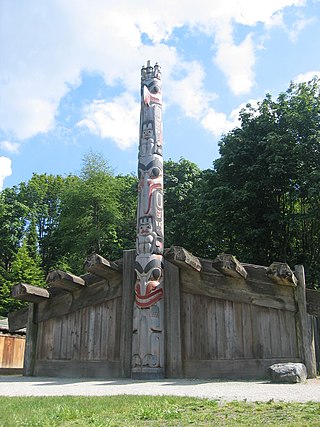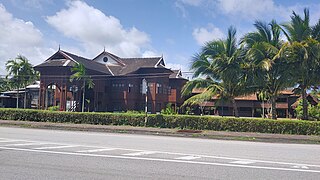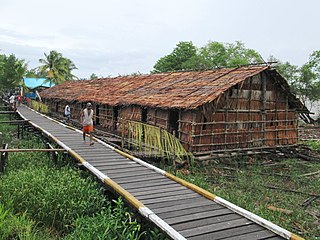
A barn is an agricultural building usually on farms and used for various purposes. In North America, a barn refers to structures that house livestock, including cattle and horses, as well as equipment and fodder, and often grain. As a result, the term barn is often qualified e.g. tobacco barn, dairy barn, cow house, sheep barn, potato barn. In the British Isles, the term barn is restricted mainly to storage structures for unthreshed cereals and fodder, the terms byre or shippon being applied to cow shelters, whereas horses are kept in buildings known as stables. In mainland Europe, however, barns were often part of integrated structures known as byre-dwellings. In addition, barns may be used for equipment storage, as a covered workplace, and for activities such as threshing.

A longhouse or long house is a type of long, proportionately narrow, single-room building for communal dwelling. It has been built in various parts of the world including Asia, Europe, and North America.

The Dani are an ethnic group from the Central Highlands of Western New Guinea in Baliem Valley, Highland Papua, Indonesia. Around 100,000 people live in the Baliem Valley, consisting of representatives of the Dani tribes in the lower and upper parts of the valley each 20,000 and 50,000 in the middle part. The areas west of the Baliem Valley are inhabited by approx 180,000, representatives of the Lani people, incorrectly called "Western Dani". All inhabitants of Baliem Valley and the surrounding areas are often called Dani hence they are also sometimes conflated with other highland tribes such as Lani in the west; Walak in the north; Nduga, Mek, and Yali in the south and east.

Malay houses refer to the vernacular dwellings of the Malays, an ethno-linguistic group inhabiting Sumatra, coastal Borneo and the Malay Peninsula.

Framing, in construction, is the fitting together of pieces to give a structure, particularly a building, support and shape. Framing materials are usually wood, engineered wood, or structural steel. The alternative to framed construction is generally called mass wall construction, where horizontal layers of stacked materials such as log building, masonry, rammed earth, adobe, etc. are used without framing.

Rumah Gadang or Rumah Bagonjong "house for the Minangkabau people" are the traditional homes of the Minangkabau in West Sumatra, Indonesia. The architecture, construction, internal and external decoration, and the functions of the house reflect the culture and values of the Minangkabau. A Rumah Gadang serves as a residence, a hall for family meetings, and for ceremonial activities. In the matrilineal Minangkabau society, the Rumah Gadang is owned by the women of the family who live there; ownership is passed from mother to daughter.

The Arfak Mountains is a mountain range found on the Bird's Head Peninsula in the Province of West Papua, Indonesia.
A burdei or bordei is a type of pit-house or half-dugout shelter, somewhat between a sod house and a log cabin. This style is native to the Carpathian Mountains and forest steppes of Eastern Europe.

Yali are a major tribal group in Highland Papua, Indonesia, and live to the east of the Baliem Valley, mainly in Yalimo Regency, Yahukimo Regency, and the surrounding regions.

Rumoh Aceh is a type of traditional vernacular house found in the Aceh Province in Indonesia. It is basically a wooden pile dwelling. Rumoh Aceh is the largest and tallest of all vernacular house types found in Aceh Province, the others are the Rumoh Santeut and the Rangkang.

Batak architecture refers to the related architectural traditions and designs of the various Batak peoples of North Sumatra, Indonesia. Six groups of Batak speak separate but related languages: the Angkola, the Mandailing to the south, the Toba, to the north the Pakpak/Dairi, the Simalungun, and the Karo. While the groups are now Muslim or Christian, elements of the ancient Batak religion remain, particularly amongst the Karo.

Rumah adat are traditional houses built in any of the vernacular architecture styles of Indonesia, collectively belonging to the Austronesian architecture. The traditional houses and settlements of the several hundreds ethnic groups of Indonesia are extremely varied and all have their own specific history. It is the Indonesian variants of the whole Austronesian architecture found all over places where Austronesian people inhabited from the Pacific to Madagascar each having their own history, culture and style.
The Damal or Damalme are a group of people living in the highlands of the Central Papua province of Indonesia. They primarily live in Beoga Valley along the river of Beogong. The Damal people are closely related to the Delem people and the Amungme people living in the southern lowland region. Delem is an ethnic group reportedly descended from the Damal people, Dani people, and Wano people.

Võmmorski old tsässon is a small Seto chapel in Võmmorski village, Setomaa Parish, Võru County in southeastern Estonia. Tsässon was built about 1911 and was dedicated for Whitsunday, also known as Pentecost. It is situated in the middle of Võmmorski, on a crossroad south from the Piusa River.

Rumah ulu is a vernacular house found in the highlands of South Sumatra, Indonesia. The house is associated with the Uluan people, who reside in the region upstream of the Ogan and Musi rivers.

Rumah Warisan Haji Su is a complex of two traditional Malay houses located in mukim Losong, two kilometres from downtown Kuala Terengganu, Terengganu. The houses were owned by Haji Su Mohammed Salleh, which he inherited from his family. Haji Su was a shipping magnate in the pre-wars day and was record to have owned several ships or Perahu Besar plying the sea to Southern Thailand and a steam ship plying south to Singapore. After a renovation process by Lembaga Muzium Terengganu, the houses were reopened as heritage buildings and tourist attraction.

Highland Papua is a province of Indonesia, which roughly follows the borders of the Papuan customary region of Lano-Pago. It covers an area of 51,213.33 km2 (19,773.58 sq mi) and had a population of 1,448,360 according to the official estimates as at mid 2023.

Jew, also known as the bachelor house, is an Asmat traditional house originating from the Asmat Regency, particularly from Agats. Jew, also known by several other names such as Je, Jeu, Yeu, or Yai, is a rectangular elevated house made of wood, with walls and roofs made of woven sago palm or nipa palm leaves. Jew entirely avoids using nails and uses rattan roots as connectors instead.

The thousand legs house is the traditional house of the Arfak people who reside in Manokwari Regency, West Papua.

The Tobati people are an ethnic group from Jayapura, Indonesia. The Tobati people inhabit the coastal area of Youtefa Bay, covering an area of 1,675 hectares within the South Jayapura district, and they have constructed settlements above the sea.





















